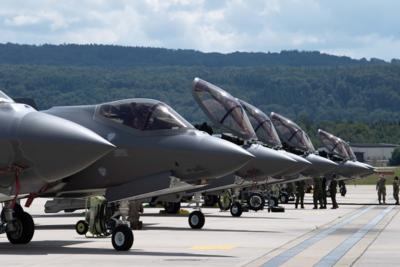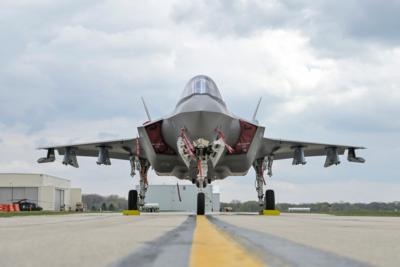Wed, Jul 17, 2024
Temporarily Reduced Functionality is an Appropriate Trade-Off to Get Deliveries Started Again
Lockheed Martin's backlog of F-35 Lightning IIs will soon be cleared to leave the nest and head to their new homes now that a 'truncated' version of their Technology Refresh 3 package is approved.

As seems to be the norm for Lockheed Martin's expensive fighter, development is behind on its timelines, with the TR-3 suite facing issues to the point that deliveries have been paused altogether. The DOD didn't want to accept F-35's without the TR-3 upgrade, which has effectively paused all deliveries until the Joint Program Office could find a build that works. Now, the JPO has approved the delivery of aircraft with a truncated version of its TR-3 software on board, which will provide a modicum of Block 4 F-35 functionality with the expectation it will be replaced with more fleshed-out versions in the future. The TR-3 package of displays, processors, and software underpin the F-35's Block 4 upgrade, providing the needed digital 'oomph' to make the most of its new hardware. Earlier this year, Lockheed had said that they'd have somewhere from 100 to 120 jets in long-term storage by the middle of 2024, including fighters destined for US military branches and F-35 partners abroad. If all goes well with
filing the paperwork, Lockheed could start delivering their aircraft immediately, which would be great news for Lightning operators around the world.
It's not too surprising that the military is embracing the same model as everyone in the commercial sphere: Ship first, and update later. As recently as May, there was hesitation about giving TR-3 the go-ahead, since reports had mentioned some user issues with the then-current form of the software. Having to reboot multiple times in the course of a flight doesn't instill much confidence in a fighter, at least. But Lieutenant General Michael J. Schmidt, F-35 program executive officer, is optimistic that they can get a version shipped that will strike a balance between being reliable and combat effective today while retaining room to grow. His approval is the thing that got the gears moving again on a truncated TR-3. Schmidt's blessing will mean a lot for the program, allowing operators to breathe easy with a revised software suite.

The important part for the DOD is that new production aircraft will have TR-3 and Block 4 installed from the start, precluding an overhaul in the future. It's a passable stopgap for now, giving users enough combat capability with the promise of better next-generation capabilities to come. It's no wonder Block 4 has given them some trouble: Originally, it was slated to add 66 new capabilities to the F-35, but improvements to tech led planners to keep adding to the pile until today's iteration boasts about 80 in all. That's led some in the JPO to hint that a reimagined version of Block 4 could be in the cards, a suite that improves on the F-35's electronic warfare, communications, navigation, armament, and identification systems.
More News
He Attempted To Restart The Engine Three Times. On The Third Restart Attempt, He Noticed That Flames Were Coming Out From The Right Wing Near The Fuel Cap Analysis: The pilot repor>[...]
Make Sure You NEVER Miss A New Story From Aero-News Network Do you ever feel like you never see posts from a certain person or page on Facebook or Instagram? Here’s how you c>[...]
From 2009 (YouTube Edition): Leading Air Show Performers Give Their Best Advice for Newcomers On December 6th through December 9th, the Paris Las Vegas Hotel hosted over 1,500 air >[...]
Aero Linx: NASA ASRS ASRS captures confidential reports, analyzes the resulting aviation safety data, and disseminates vital information to the aviation community. The ASRS is an i>[...]
“For our inaugural Pylon Racing Seminar in Roswell, we were thrilled to certify 60 pilots across our six closed-course pylon race classes. Not only did this year’s PRS >[...]
 NTSB Final Report: Rutan Long-EZ
NTSB Final Report: Rutan Long-EZ ANN FAQ: Turn On Post Notifications
ANN FAQ: Turn On Post Notifications Classic Aero-TV: ICAS Perspectives - Advice for New Air Show Performers
Classic Aero-TV: ICAS Perspectives - Advice for New Air Show Performers ANN's Daily Aero-Linx (06.28.25)
ANN's Daily Aero-Linx (06.28.25) Aero-News: Quote of the Day (06.28.25)
Aero-News: Quote of the Day (06.28.25)




